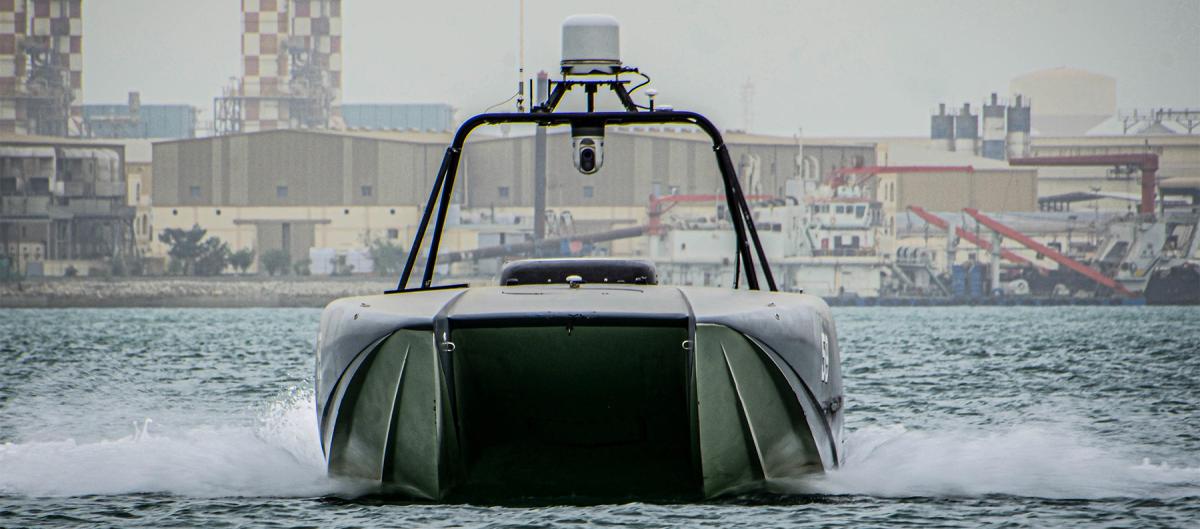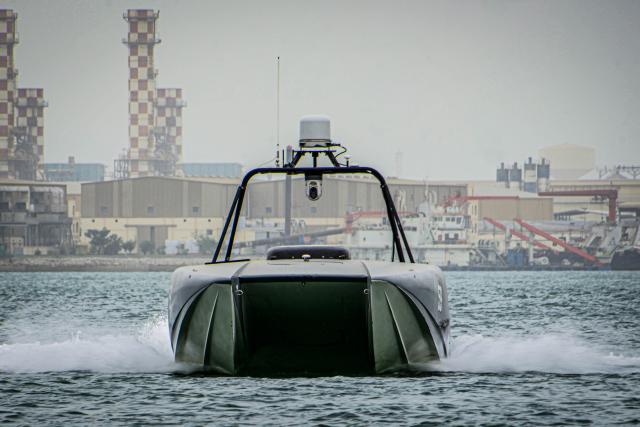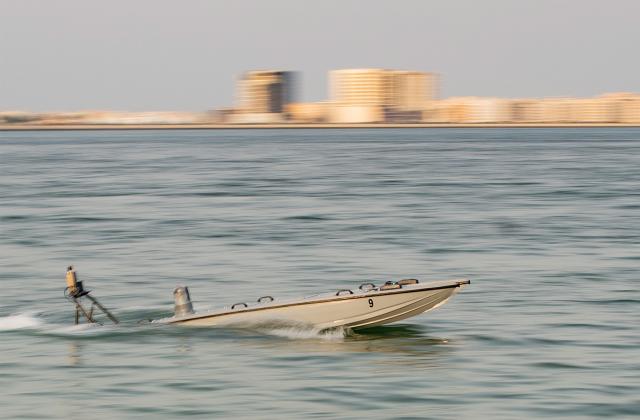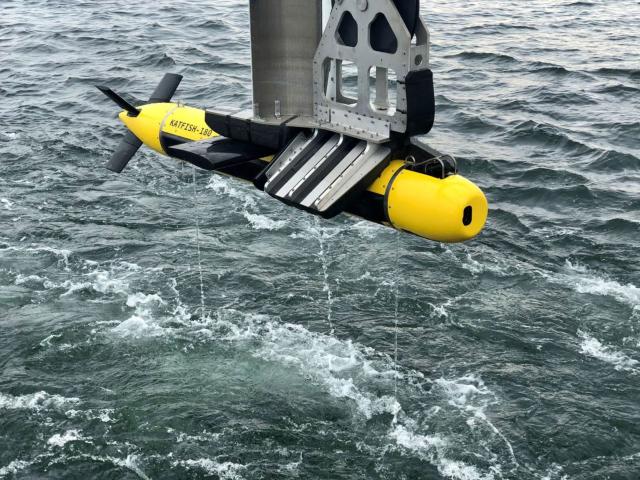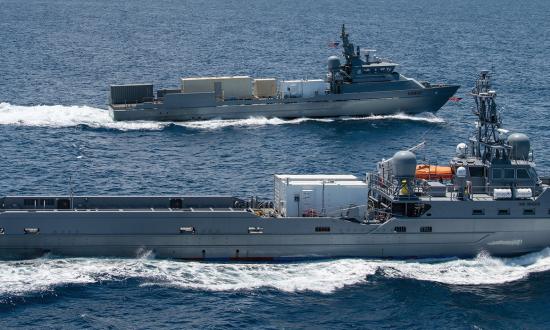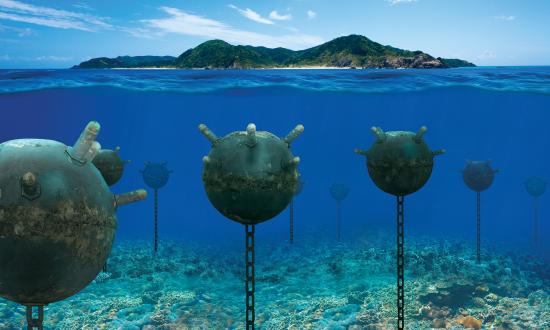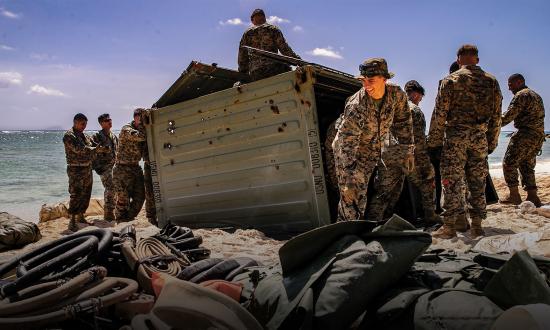The Department of the Navy has ambitious plans for integrating unmanned systems (UxS) into the fleet and Fleet Marine Force. These plans are described in the tri-service maritime strategy, Advantage at Sea, and, most recently, in the Navy’s Unmanned Campaign Framework.1 However, this aspiration has collided with congressional—and other—concerns that the Navy and Marine Corps have yet to come up with a convincing concept of operations (ConOps) for using the small, medium, and large unmanned vehicles it intends to buy. Unless or until the Department of the Navy can articulate how it intends to use these vehicles across the spectrum of conflict, the Framework will remain nothing more than an aspirational vision.
Growing Aspirations
The Navy has a rich history of UxS development. During the early years of the 20th century, it worked with the Army to attempt to develop unmanned aerial torpedoes. This was a bridge too far, however, given the existing state of technology, and the project was abandoned. Other attempts to introduce unmanned systems into the Navy and Marine Corps occurred in fits and starts, but they met with limited success.2
By the turn of the century, the technology to control unmanned systems had matured to the point that the Navy believed it could field these systems successfully in all domains—air, surface, and subsurface—to meet a wide variety of operational needs. The Chief of Naval Operations Strategic Studies Group (CNO SSG) was tasked to determine the feasibility of introducing unmanned systems into the Navy inventory, and its 2009 report spurred increased interest in—and emphasis on—unmanned systems Navy-wide.
Leveraging the SSG’s work, the Department of the Navy began to lay out a vision for inserting unmanned systems into the fleet and Fleet Marine Force. Former CNO Admiral Jonathan Greenert’s 2011 Sailing Directions noted, “Over the next 10 to 15 years . . . unmanned systems in the air and water will employ greater autonomy and be fully integrated with their manned counterparts.”3 He followed this with articles in Proceedings stressing the importance of unmanned systems.4
The vision was highlighted in a series of documents—from the revised A Cooperative Strategy for 21st Century Seapower, to A Design for Maintaining Maritime Superiority, to CNO Admiral John Richardson’s The Future Navy white paper—and reflected in the Navy’s official Force Structure Assessment and a series of “Future Fleet Architecture Studies.”5 In each study, the proposed future fleet had large numbers of air, surface, and subsurface unmanned systems.6
The Unmanned Campaign Framework notes:
The Navy and Marine Corps must innovate and accelerate delivery of credible and reliable unmanned systems in conjunction with increasingly capable manned platforms into the fleet. . . . Unmanned systems will increase lethality, capacity, survivability, operational tempo, deterrence, and operational readiness.7
However, Congress and outside observers have questioned the Department of the Navy’s zeal to purchase large numbers of unmanned systems without first articulating a concept for their use. Whether Navy leaders consider these criticisms valid or not, absent congressional—and public—approval, the Navy’s plans will not be realized.
Growing Concerns
A number of Congressional Research Service reports have addressed unmanned systems.8 Most scrutiny has focused on the Navy’s plans for unmanned surface vehicles (USVs). There are many reasons for this emphasis, but one is that air, subsurface, and ground unmanned systems are designed for discrete missions while USVs have more expansive roles. One analyst described congressional concerns:
Unmanned surface vessels are all the rage in the Office of the Secretary of Defense, and the U.S. Navy has lined up behind the effort. But Congress remains skeptical until it sees the Navy make progress on the basics.
In the latest sign of congressional ambivalence on unmanned surface warships, the House Seapower and Projection Forces subcommittee called for restricting funding for procurement of any large unmanned surface vessels—LUSVs. The Navy could not spend procurement dollars on a large unmanned surface vessel until they have a working model and not try to develop those technologies on the fly.9
Another defense publication noted:
The Navy has yet to produce a concept of operations or even a coherent public strategy to back up the investments they want to make. Further, Congress is wary of appropriating money for platforms that rely on technologies that haven’t been fully developed yet.10
Outside observers have piled on, expressing concerns that the Navy’s plans—particularly for USVs—are at best muddled and, at worst, unachievable. One national security professional wrote:
The U.S. Navy is moving forward with its plans for a more distributed fleet in which intelligent unmanned or autonomous platforms will play a significant role. Unfortunately, many of the details about these novel systems are left to the imagination. Missing from the technology discussions is how the Navy plans to sustain large quantities of unmanned systems.
Furthermore, unless these systems have exceedingly long range and endurance, launching and recovering them must be done with some proximity to their operational locations, presumably at risk of attack from the adversary. This begs the question: What part of the Navy force structure and budget will be used for large-scale sustainment of unmanned systems at sea?11
While the Navy would be hard-pressed to allay every concern, it would be well-served to begin by identifying concrete missions USVs can perform, how it will employ large, medium, and small USVs to accomplish these tasks, and how it intends to deliver them to an area of operations and sustain them once they arrive.
Evolving a Concept of Operations
The Navy’s inability to develop a convincing USV concept of operations might simply stem from a lack of imagination. It no longer should think of each USV as a “one-of,” but instead should package together multiple size and function vehicles designed for specific missions. USV ship design should emphasize modularity to accommodate sensors, payloads, and weapons for specific missions, where the platform remains constant and the modularity allows for flexibility to support multiple missions.
Because they operate at the air-sea interface, can be designed in a range of sizes, and have sustainability most of their air and subsurface counterparts lack, USVs have the potential to contribute to a variety of naval missions, from antisubmarine and antisurface warfare to electronic warfare (EW), intelligence, surveillance, and reconnaissance (ISR), mine countermeasures (MCM), and many others. While USVs can perform many of these missions, two pressing needs they can perform today are ISR and MCM.12
Central to the ISR mission is the idea that USVs typically are better suited for this effort than their unmanned aerial vehicle counterparts because of their increased ability to remain undetected by enemy sensors and their longer dwell time on station. The impetus for using USVs for the MCM mission is more compelling, as even the threat of mines can stop a naval operation in its tracks.
The Navy has conducted an array of exercises, experiments, and demonstrations using small and medium-sized USVs successfully to conduct ISR and MCM. Given the Navy’s commitment to purchase a number of large USVs, the pieces are in place to create a ConOps to perform these two vital missions by marrying small, medium, and large USVs together.
Under this ConOps, the LUSV is essentially the “truck” that delivers its smaller cousins to the area of operations. The small USVs are ideally suited for the ISR mission. The medium USV (MUSV) is the “utility infielder” or integrator that both delivers the small USVs deeper into their operating area and performs its own MCM and ISR missions.
Part of what makes this concept so achievable is that the Navy already has evaluated several MUSVs, achieving thousands of hours of at-sea time. The three platforms used most extensively are the 132-foot Sea Hunter, the 39-foot Common Unmanned Surface Vessel (CUSV), and the Devil Ray 38-foot USV.
For the purpose of this ConOps, the Devil Ray would be the MUSV, for a number of reasons: The Sea Hunter is too large to fit inside the LUSVs the Navy is evaluating, and the CUSV is part of the littoral combat ship MCM mission module and is committed to that use. In addition, the Devil Ray shares the same hull, mechanical, and electrical (HME) systems as its smaller 12-foot MANTAS cousin, which has performed the ISR function in numerous Navy and Marine Corps events over the past five years.
Putting the Pieces Together
Using this combination of platforms is not the only path to a concept of operations for the effective use of the Navy’s proposed USV fleet. However, it does leverage commercial off-the-shelf (COTS) small and medium USVs with compatible HME systems that have had hundreds of hours of in-water time in Navy and Marine Corps exercises. It also proposes an immediate use for the LUSVs the Navy is keen to procure.
This ConOps, already presented at multiple military–industry conferences, has been dubbed, “Nesting the Dolls,” as it brings to mind images of the familiar Russian nesting dolls. In this case, the LUSV carries a number of MUSVs, which are outfitted to perform the ISR or MCM mission or which carry smaller USVs to perform the ISR mission.
In concrete terms, the ConOps is built on a potential scenario involving an expeditionary strike group (ESG) underway in the western Pacific. The strike group includes three LUSVs under supervisory control from the ESG flagship. An incident occurs in their operating area and the strike group is requested to (1) obtain reconnaissance of a near-shore littoral area, and (2) determine if the entrance to a specific bay has been mined to prevent ingress. The ESG commander dispatches the three LUSVs for the mission. Two LUSVs are each configured with four Devil Ray T38 and MANTAS T12-ISR craft, and the third LUSV is configured with four T38-MCM vessels.
Once the LUSVs approach the adversary coastline, they are commanded to launch their far-stealthier MUSVs. The Devil Ray T38-ISRs are equipped with a variety of radar, electro-optical/infrared cameras, EW sensors and a multibeam sonar. Each Devil Ray launches two MANTAS T12 USVs, each configured with thermal camera, passive EW sensors, and single-beam or side-scan sonar. This extensive package of ISR assets can provide comprehensive coverage of any coastline.
Concurrently, the other LUSV launches its four Devil Ray MCM vessels. While there are multiple evolving mine-hunting and mine-neutralization systems the T38 Devil Ray can employ, two systems demonstrated during Trident Warrior 2020 were the Katfish-180 synthetic aperture sonar, optimized to search for mine-like objects, and the Pluto Gigas mine-neutralization remotely operated vehicle, which conducts the dull, dirty, and dangerous work previously conducted by Navy ships.
While the Navy is developing elegant platforms as “one-of” assets to accomplish the ISR and MCM missions at some as-yet-undefined future date, this COTS ConOps not only uses assets that are available today, but also provides a way to get them to the fight and sustain them. Since the LUSVs and the small and medium USVs are traveling with an ESG—not traversing the ocean alone as some USV visionaries advocate—there is built-in sustainment to deal with emerging HME and other issues. Once they accomplish their mission, the MUSVs return for refit and rearming to the LUSV, where fly-away teams from the ESG provide this service.
Build a Little, Test a Little, Learn a Lot
Admiral Wayne Meyer coined the phrase, “Build a Little, Test a Little, Learn a Lot” more than four decades ago, but it is appropriate that the Unmanned Campaign Framework includes it in its introduction. The Navy is doing just that with a growing number of unmanned maritime systems, and the lessons learned have helped evolve more robust USVs.
Fielding a COTS force of ISR and MCM assets does more than just get something in the water today. By showing Congress a convincing concept for how it intends to use today’s USVs to perform vital missions, the Navy may make Congress more inclined to invest in even more capable platforms that will make the lofty vision of the Framework a reality and help the Navy and the nation prevail in the high-end fight.
1. Department of the Navy, Unmanned Campaign Framework (Washington, DC: Department of the Navy, 16 March 2021).
2. For a concise recap of the Navy’s efforts to field unmanned systems, see Kyle Mizokami, “The Surprising History of Unmanned Navy Systems,” U.S. Naval Institute Proceedings 46, no. 6 (June 2020).
3. ADM Jonathan Greenert, USN, Sailing Directions, 23 September 2011.
4. ADM Jonathan Greenert, USN, “Navy 2025: Forward Warfighters,” U.S. Naval Institute Proceedings 137, no. 12 (December 2011), and ADM Jonathan Greenert, USN, “Payloads Over Platforms: Charting a New Course,” U.S. Naval Institute Proceedings 138, no 7 (July 2012).
5. See, for example, “Document, Summary of the Navy’s New Force Structure Assessment,” USNI News, 16 December 2016 (updated 6 April 2017), news.usni.org/2016/12/16/document-summary-navys-new-force-structure-assessment, for an executive summary of this document.
6. See, for example, Navy Project Team, Report to Congress: Alternative Future Fleet Platform Architecture Study, 27 October 2016; MITRE, Navy Future Fleet Platform Architecture Study, 1 July 2016; and CSBA, Restoring American Seapower: A New Fleet Architecture for the United States Navy, 23 January 2017.
7. Department of the Navy, Unmanned Campaign Framework. See also, Department of the Navy, Science and Technology Strategy for Intelligent Autonomous Systems (Washington, DC: Department of the Navy, 2 July 2021).
8. Ronald O’Rourke, Navy Large Unmanned Surface and Undersea Vehicles: Background and Issues for Congress, CRS Report 45757 (Washington, DC: Congressional Research Service, 9 December 2021). While the primary focus of the report is larger USVs, it also provides a comprehensive overview of the Navy’s plans for medium-sized USVs.
9. Lauren Williams, “Lawmakers Skeptical of Seaborne Drone Fleet,” Defense Systems, 24 June 2020.
10. David Larter, “The Pentagon Wants to Forge Ahead with Robot Warships, But Congress Wants to Slow the Train,” Defense News, 19 June 19, 2020.
11. Gregory Cox, “The U.S. Navy’s Plans for Unmanned and Autonomous Systems Leave Too Much Unexplained,” War on the Rocks, 10 December 2021.
12. Jack Rowley, “Integrating Unmanned Surface Vehicles Into the Surface Fleet: The Case for a ‘Nesting Dolls’ Approach,” paper presented at the American Society of Naval Engineers 2021 Virtual Technology, Systems and Ships Symposium, 26-28 January 2021.



